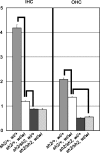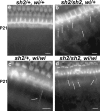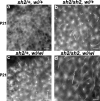Whirler mutant hair cells have less severe pathology than shaker 2 or double mutants
- PMID: 17619105
- PMCID: PMC2538434
- DOI: 10.1007/s10162-007-0083-x
Whirler mutant hair cells have less severe pathology than shaker 2 or double mutants
Abstract
MYOSIN XV is a motor protein that interacts with the PDZ domain-containing protein WHIRLIN and transports WHIRLIN to the tips of the stereocilia. Shaker 2 (sh2) mice have a mutation in the motor domain of MYOSIN XV and exhibit congenital deafness and circling behavior, probably because of abnormally short stereocilia. Whirler (wi) mice have a similar phenotype caused by a deletion in the third PDZ domain of WHIRLIN. We compared the morphology of Whrn (wi/wi) and Myo15 (sh2/sh2) sensory hair cells and found that Myo15 (sh2/sh2) have more frequent pathology at the base of inner hair cells than Whrn (wi/wi), and shorter outer hair cell stereocilia. Considering the functional and morphologic similarities in the phenotypes caused by mutations in Myo15 and Whrn, and the physical interaction between their encoded proteins, we used a genetic approach to test for functional overlap. Double heterozygotes (Myo15 (sh2/+), Whrn (wi/+)) have normal hearing and no increase in hearing loss compared to normal littermates. Single and double mutants (Myo15 (sh2/sh2), Whrn (wi/wi)) exhibit abnormal persistence of kinocilia and microvilli, and develop abnormal cytoskeletal architecture. Double mutants are also similar to the single mutants in viability, circling behavior, and lack of a Preyer reflex. The morphology of cochlear hair cell stereocilia in double mutants reflects a dominance of the more severe Myo15 (sh2/sh2) phenotype over the Whrn (wi/wi) phenotype. This suggests that MYOSIN XV may interact with other proteins besides WHIRLIN that are important for hair cell maturation.
Figures







Similar articles
-
Myosin-XVa is required for tip localization of whirlin and differential elongation of hair-cell stereocilia.Nat Cell Biol. 2005 Feb;7(2):148-56. doi: 10.1038/ncb1219. Epub 2005 Jan 16. Nat Cell Biol. 2005. PMID: 15654330
-
Myosin-XVa Controls Both Staircase Architecture and Diameter Gradation of Stereocilia Rows in the Auditory Hair Cell Bundles.J Assoc Res Otolaryngol. 2020 Apr;21(2):121-135. doi: 10.1007/s10162-020-00745-4. Epub 2020 Mar 9. J Assoc Res Otolaryngol. 2020. PMID: 32152769 Free PMC article.
-
Fast adaptation and Ca2+ sensitivity of the mechanotransducer require myosin-XVa in inner but not outer cochlear hair cells.J Neurosci. 2009 Apr 1;29(13):4023-34. doi: 10.1523/JNEUROSCI.4566-08.2009. J Neurosci. 2009. PMID: 19339598 Free PMC article.
-
Unconventional myosins and the genetics of hearing loss.Am J Med Genet. 1999 Sep 24;89(3):147-57. doi: 10.1002/(sici)1096-8628(19990924)89:3<147::aid-ajmg5>3.0.co;2-6. Am J Med Genet. 1999. PMID: 10704189 Review.
-
[Usher syndrome type I and the differentiation of inner ear sensory cells' hair bundles].Med Sci (Paris). 2005 Aug-Sep;21(8-9):737-40. doi: 10.1051/medsci/2005218-9737. Med Sci (Paris). 2005. PMID: 16115459 Review. French.
Cited by
-
Usher syndrome and non-syndromic deafness: Functions of different whirlin isoforms in the cochlea, vestibular organs, and retina.Hear Res. 2019 Apr;375:14-24. doi: 10.1016/j.heares.2019.02.007. Epub 2019 Feb 22. Hear Res. 2019. PMID: 30831381 Free PMC article. Review.
-
Building and repairing the stereocilia cytoskeleton in mammalian auditory hair cells.Hear Res. 2019 May;376:47-57. doi: 10.1016/j.heares.2018.12.012. Epub 2019 Jan 2. Hear Res. 2019. PMID: 30638948 Free PMC article. Review.
-
Regulation of stereocilia length by myosin XVa and whirlin depends on the actin-regulatory protein Eps8.Curr Biol. 2011 Jan 25;21(2):167-72. doi: 10.1016/j.cub.2010.12.046. Epub 2011 Jan 13. Curr Biol. 2011. PMID: 21236676 Free PMC article.
-
CIB2, defective in isolated deafness, is key for auditory hair cell mechanotransduction and survival.EMBO Mol Med. 2017 Dec;9(12):1711-1731. doi: 10.15252/emmm.201708087. EMBO Mol Med. 2017. PMID: 29084757 Free PMC article.
-
Primary cilia in planar cell polarity regulation of the inner ear.Curr Top Dev Biol. 2008;85:197-224. doi: 10.1016/S0070-2153(08)00808-9. Curr Top Dev Biol. 2008. PMID: 19147007 Free PMC article. Review.
References
-
- {'text': '', 'ref_index': 1, 'ids': [{'type': 'DOI', 'value': '10.1093/hmg/9.12.1729', 'is_inner': False, 'url': 'https://doi.org/10.1093/hmg/9.12.1729'}, {'type': 'PubMed', 'value': '10915760', 'is_inner': True, 'url': 'https://pubmed.ncbi.nlm.nih.gov/10915760/'}]}
- Anderson DW, Probst FJ, Belyantseva IA, Fridell RA, Beyer L, Martin DM, Wu D, Kachar B, Friedman TB, Raphael Y, Camper SA. The motor and tail regions of myosin XV are critical for development and function of the auditory and vestibular systems. Hum. Mol. Genet. 9:1729–1738, 2000. - PubMed
-
- {'text': '', 'ref_index': 1, 'ids': [{'type': 'DOI', 'value': '10.1007/BF00305923', 'is_inner': False, 'url': 'https://doi.org/10.1007/bf00305923'}, {'type': 'PubMed', 'value': '6869851', 'is_inner': True, 'url': 'https://pubmed.ncbi.nlm.nih.gov/6869851/'}]}
- Anniko M. Postnatal maturation of cochlear sensory hairs in the mouse. Anat. Embryol. (Berl) 166(3):355–368, 1983. - PubMed
-
- {'text': '', 'ref_index': 1, 'ids': [{'type': 'DOI', 'value': '10.1038/ncb1219', 'is_inner': False, 'url': 'https://doi.org/10.1038/ncb1219'}, {'type': 'PubMed', 'value': '15654330', 'is_inner': True, 'url': 'https://pubmed.ncbi.nlm.nih.gov/15654330/'}]}
- Belyantseva IA, Boger ET, Naz S, Frolenkov GI, Sellers JR, Ahmed ZM, Griffith AJ, Friedman TB. Myosin-XVa is required for tip localization of whirlin and differential elongation of hair-cell stereocilia. Nat. Cell Biol. 7(2):148–56, 2005. - PubMed
-
- {'text': '', 'ref_index': 1, 'ids': [{'type': 'DOI', 'value': '10.1023/A:1026515619443', 'is_inner': False, 'url': 'https://doi.org/10.1023/a:1026515619443'}, {'type': 'PubMed', 'value': '11276175', 'is_inner': True, 'url': 'https://pubmed.ncbi.nlm.nih.gov/11276175/'}]}
- Beyer LA, Odeh H, Probst FJ, Lambert EH, Dolan DF, Camper SA, Kohrman DC, Raphael Y. Hair cells in the inner ear of the pirouette and shaker 2 mutant mice. J. Neurocytol. 29:227–239, 2000. - PubMed
-
- {'text': '', 'ref_index': 1, 'ids': [{'type': 'DOI', 'value': '10.1093/hmg/ddi036', 'is_inner': False, 'url': 'https://doi.org/10.1093/hmg/ddi036'}, {'type': 'PubMed', 'value': '15590698', 'is_inner': True, 'url': 'https://pubmed.ncbi.nlm.nih.gov/15590698/'}]}
- Delprat B, Michel V, Goodyear R, Yamasaki Y, Michalski N, El-Amraoui A, Perfettini I, Legrain P, Richardson G, Hardelin JP, Petit C. Myosin XVa and whirlin, two deafness gene products required for hair bundle growth, are located at the stereocilia tips and interact directly. Hum. Mol. Genet. 14(3):401–410, 2005. - PubMed
Publication types
MeSH terms
Substances
Grants and funding
LinkOut - more resources
Full Text Sources

